Chinese Woman Dresses Up Kid as Brithish Palace Guard
No trip to England is complete without seeing a redcoat. There's no more iconic image of the British Empire than a redcoat soldier, either at a changing of the guard, protecting one of the Queen's palaces (as they have done for 359 years), or in paintings from Bunker Hill to Waterloo. And yet the place most people see one (or try to) is probably the worst – the massive and touristy daily changing of the guard at Buckingham Palace.
Of course, you have to see that. At least once. But here are some other places and ideas where you can see redcoats in much better circumstances.
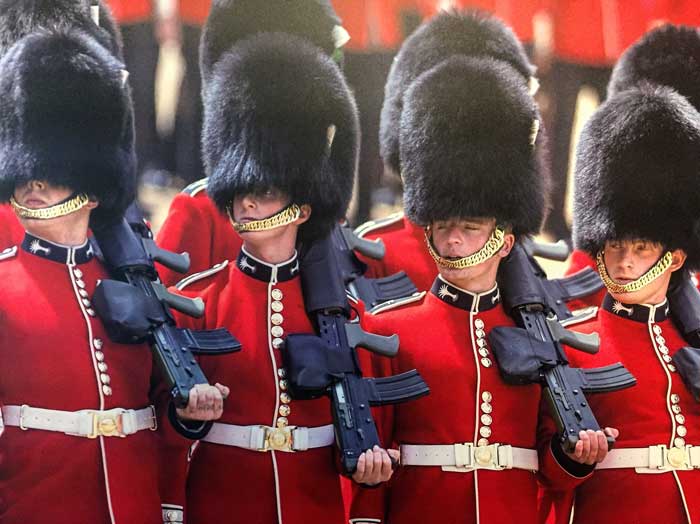
Why Did the British Wear Redcoats?
In the 21st century, it seems insane for soldiers to wear bright red coats since that would make them an easy target. The theory that red coats hid blood doesn't hold up. Blood stains show up very well as black on a red coat.
The main reason British soldiers wore red was that red dye was cheaper than blue or other colors. And red had a long association with England. Throughout history, red and purple were the preferred colors of royalty. Also, on a battlefield filled with smoke, it didn't hurt to be able to see red so as not to fire on your own troops – a constant problem in gunpowder warfare. British soldiers wore red in battle until 1885, when the redcoats retired to ceremonial use only.
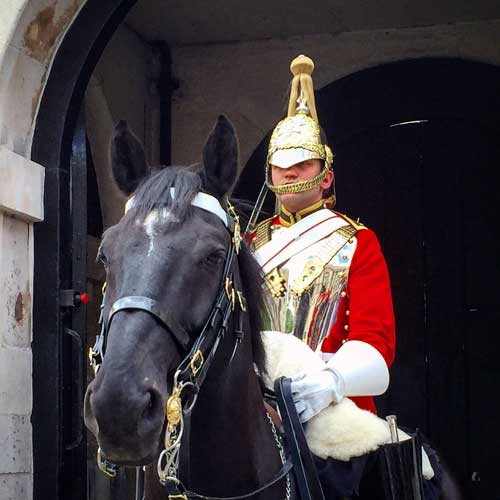
The main sources for the red dye were the roots of the rose madder plant, which had been used to make red dye by King Tut in 1500 BC through the Roman Empire. In the 1500s, a much brighter scarlet dye was brought to Europe by Cortez. It was made from cochineal, a small bug that lived on cactus in Mexico. Montezuma, king of the Aztecs, received tax payments in cochineal, which could take 100,000 bug shells to create one kilo of dye.
The Spanish kept the source of their red dye secrete for 300 years. Despite many spies and bribes, the British never learned the truth that it came from a bug — they thought that cochineal was a berry. As a consequence, they always had to buy their red scarlet dye from the Spanish. However, they got to a good start in 1597 when, acting as pirates, Sir Walter Raleigh and the Earl of Essex captured three Spanish ships with 27 tons of cochineal and presented 10 percent of the treasure to Queen Elizabeth I.
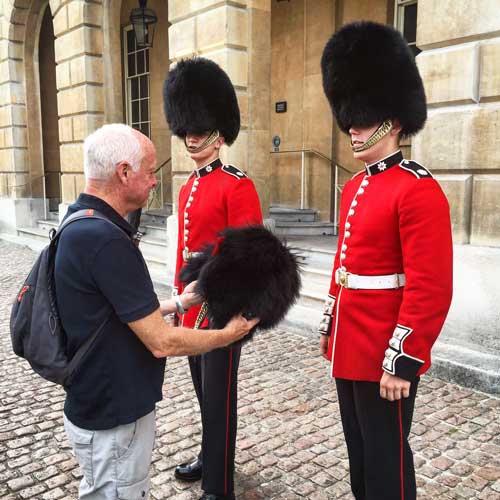
Are the Queen's Guard Hats Really Bearskin?
And the hats? Yes, they really are bearskin. In fact, each 1.5-pound hat requires a full bearskin. The British army buys 50-100 bearskins a year from among the thousands of black bears killed annually by native Inuit hunters in Canada. Private soldiers get black bearskins; the officers wear brown bear hats, which are thicker and prettier, though they have to be dyed black. A well maintained bear hat can last for decades. Here's where to see those famous black hats.
Changing of the Royal Guard at Buckingham Palace
Well, everyone has to see the changing of the guard at Buckingham Palace at least once. Household Troops, better known as 'the Guards,' have guarded the Sovereign and the Royal Palaces since the Restoration of Charles II in 1660. The challenge is that most of this "changing of the guard" takes place behind a big fence on the palace grounds.
There are huge crowds, you have to get there an hour early (at least by 10 a.m. for the 11 a.m. show) and there are very few photo opportunities. A better idea is to walk two blocks east from the palace and hang out at Wellington Barracks on the pleasantly named street, Birdcage Walk.
This is where the "new guard" and the band form up. There's fewer people, you can see just as many redcoats, and you'll actually hear (fleetingly) the 50-soldier band and drum corps as they begin their march to the palace and the crowds. This same band (accompanied by the "old guard") comes back this way a half hour later. Spend the interval strolling around adjacent and pretty St. James Park, watching swans swim across the lake.
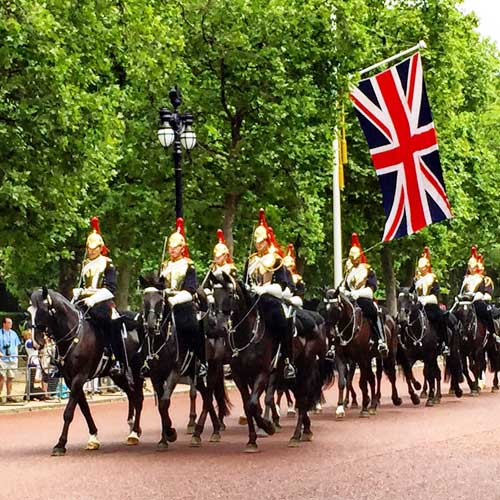
The Horse Guards
Every day since 1660, no matter what the weather, mounted cavalry troops have ridden down the streets of London and stood at the House Guards – the official entrance to Buckingham Palace.
Today, the task is assigned to the Queen's Life Guards (red uniforms with white plumed helmets) and the Blues and Royals (blue uniforms and red plumed helmets), all on immaculately groomed horses. They are members of the Household Cavalry and they ride each morning with polished breastplates and gleaming helmets from the barracks and stables in Hyde Park, performing a half hour changing of the guard ceremony on horseback at 11 a.m. weekdays and 10:00 a.m. Sundays.

There are no barricades between you and the troops and it's a grand show. When the Queen is at residence in Buckingham, it's even better with slightly more troops and a Royal Salute performed by trumpet.
After the changing, the most photographed celebrities in England are the dismounted sentries, who stand patiently while thousands of tourists run up and snap a selfie next to them.
One mounted cavalry troop stands next to a sign that says, "Beware: Horses May Kick or Bite." They're not the only ones. Remember, despite the swords, these are modern troops, many of whom have seen combat. The occasional tourist who gets too close might get a bite – and a kick in the ass – which often goes viral on Facebook.
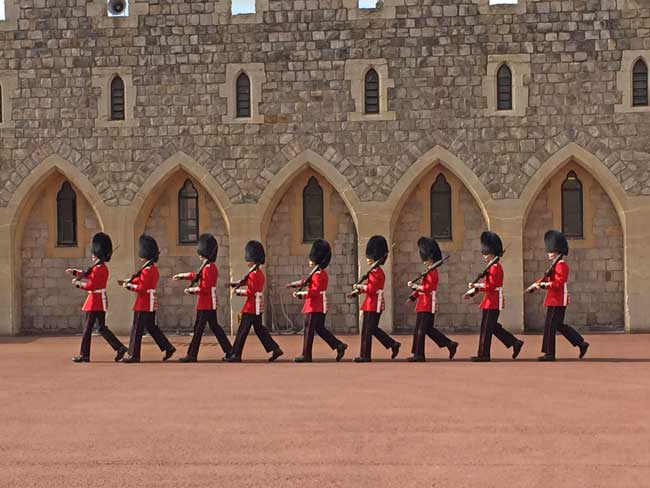
Changing of the Guard at Windsor Castle
Windsor Castle is the largest and oldest continuously inhabited castle in the world. It's also the Queen's favorite residence, where she spends most weekends. You can tell if she's home by the flagpole on the round tower. If she's there, it flies her standard; if not the you'll see a Union Jack.
Built in the 11th century, the castle has been home to 39 monarchs. It's located just 35 minutes from Paddington Station with trains leaving every 15 minutes, and should be a must for anyone going to London.
The surrounding town, the castle grounds, walking paths along the river, historic pubs and the countryside are like a Great Britain theme park, a completely different experience than the bustle of London. It also has the best changing of the guard ceremony.
Times vary for the Changing of the Guard at Windsor Castle, and it's not a daily occurrence, so always check the schedule. https://changing-guard.com/dates-windsor-castle.html
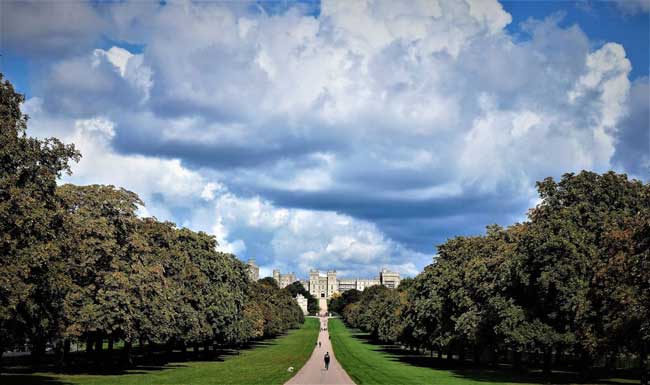
Visiting Windsor Castle
You can watch the guards and band stop traffic and march through town for free, but better is to buy your castle ticket in advance (online to save waiting) and be in place by 10:30. The guards march in at 11 a.m. at the Henry VIII Gate, unless the Queen is in residence, in which case they use the St. George's Gate.
You can watch half the ceremony, which takes place very photogenically beneath the castle walls, then be in position by the gate when the band and the old guard march out. From here, you are so close you could touch them, but of course, one look at the bayonets and that might be the last thing you do.
A good tip is to get your ticket stamped and exit with the old guard for a pub lunch. The tour buses will leave after the changing, and when you go back to tour the castle after a pint in a pub, the crowds will be greatly reduced. But save time to walk the castle grounds (most recently famous for the royal wedding of Prince Harry and Meghan Markle), take a stroll along the River Thames with its many swans, then cross the bridge and visit the college town of Eaton.

Tower of London
The Tower of London has been a storehouse for jewels, crowns and royal robes for more than 600 years. Some 30 million people have seen the "Crown Jewels," which include the Sovereign's Scepter with the world's largest diamond (530.2 carats!); the Imperial State Crown with 2,868 diamonds, 17 sapphires, 11 emeralds, 269 pearls and 4 rubies; and, oh, some other crowns and robes covered with more than 25,000 gem stones. Most amazing is that this is a unique working collection – the Queen still wears the Imperial State Crown at the opening of Parliament.
And guarding all this? Well, besides high tech wonders, there are 15 guardsmen who take turns standing outside the Crown Jewels beside a row of cannons that were captured at Waterloo. The changing of the guard here is small, but it's marvelous just to see the red coat and bearskin hatted guardsmen still on the job, guarding the greatest treasure on the planet.
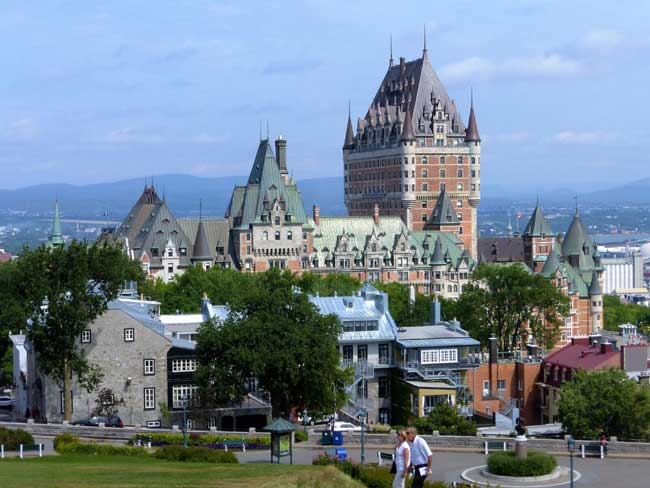
Changing of the Guard at the Citadelle in Quebec
What would it have been like if Napoleon had invaded England and won? Well, you can get some idea at the Citadelle in Quebec, Canada, where a daily changing of the guard looks just like the one in London – only the commands are shouted in French!
In the mid-19th century, British Canadians, fed up by two American invasions of Canada in the Revolution and War of 1812, decided to build the Citadelle, an impregnable "fort within a fort" — the "Gibraltar of America" — a place that was so powerful, it was never attacked. Today, the star-shaped Vauban fortifications offer a look at 300 years of military architecture.
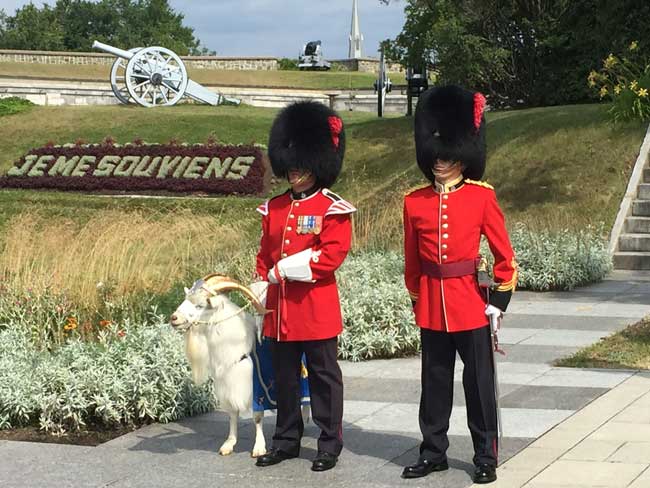
The highlight of a summer visit to Quebec City is the daily changing of the guard. This is an active fort and the Royal 22nd Regiment is still stationed here, wearing the same scarlet uniforms and bear skin hats. Look for troops who seem to be shorter than the others. They are women. Some 10 percent of the regiment are women, and women participate in the changing of the guard ceremony, even as officers.
This is the only French regiment in Canada and so all orders to it must be given in French. Even Queen Elizabeth must give orders in French. The Queen gave the regiment a Persian goat in 1955 to act as mascot and now the third generation of the goat, always named Batisse, is at every changing of the guard ceremony, posing for photos.
Don't tell anyone, but there are actually three goats named Batisse. The guides seem quite jealous of the goats. "Each goat has to work only once every three days and the rest of the time they get to hang out with their girlfriends," our guide said.
The views from the Citadel over Quebec are the best in the city, but you'll have to see them fast. This is a working fort and they don't allow lingering.
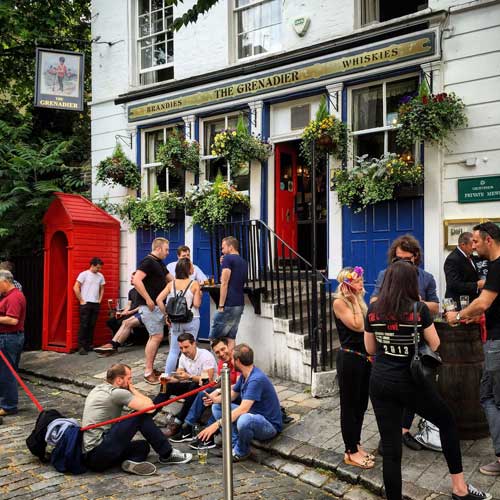
Have a Pint with Grenadier in Belgrave Square
The Grenadier in Belgrave Square is a historic pub that dates back to 1720, when it was built as an officer's mess. With swinging pub signs of red coated guardsmen, a bright red sentry box, and interior walls covered with battle scenes, uniforms and prints of soldiers, the pub was a favorite of the Duke of Wellington and now with its strong traditional English menu entertains notables like Madonna and Prince William. It's hidden down an alley near Hyde Park Corner and the Wellington Arch, but well worth the effort to find it.
Take Home a Miniature Redcoat
In 1893, William Britain invented a way of making hollow lead toy soldiers, and hundreds of thousands of soldiers later, vast armies of redcoats have invaded every souvenir shop in London. Most places sell toy soldier guardsmen, Scottish pipers, or even Queen Elizabeth in a red coat on a horse, but the Armoury of St. James in the covered Victorian Piccadilly Arcade is the place to go.
The shop is simply stuffed with historic military hats, helmets, flags, swords, guns …. and toy soldiers, hundreds of which are presented in intricate dioramas of historic battles from Waterloo to the Zulu wars. These toy soldiers run in the neighborhood of $40 each, but are true historic models with every button and epaulette the correct colors.
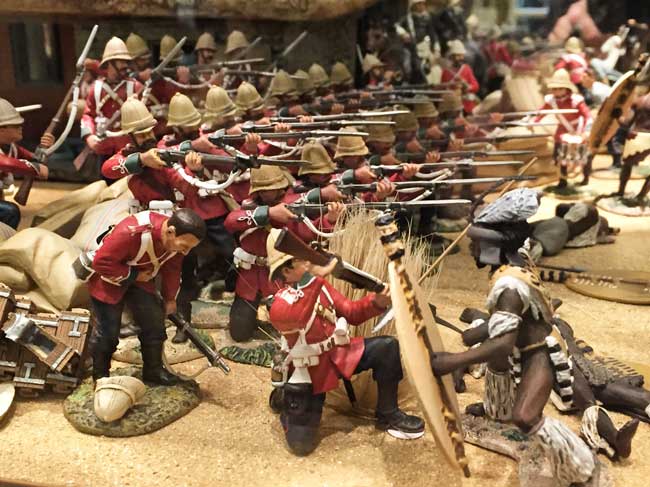
Buy a Real Redcoat
There's plenty of real military redcoats for sale at antique shops, London's outdoor markets, and even in the outdoor stalls at Covent Gardens. Where you would ever wear a redcoat, is a different matter.
Special Events
The British love history and they have plenty of it, so it's a rare time when some famous event is not celebrating an anniversary. My brother and I happened to stumble on one celebrating the 200th Anniversary of Waterloo, where a half dozen Grenadiers, Life Guards and Blues and Royals were standing around waiting to march.
You have to remember these are soldiers, not actors, and as such, are often bored and happy to talk to a couple of yanks about the army, uniforms, history….and most important….let us hold a bearskin hat.
Of course, the biggest ceremony is Trooping the Colour, also known as the Queen's Birthday Parade, which features 1,400 soldiers and officers, hundreds of horses, and 400 musicians.
This year it will be held on June 8, 2019 (not the Queen's real 93rd birthday, but better weather). There are full dress rehearsals with smaller crowds and no Queen on May 25 and June 1, 2019. There are numerous other parades, artillery barrages, and ceremonies throughout the year at https://changing-guard.com
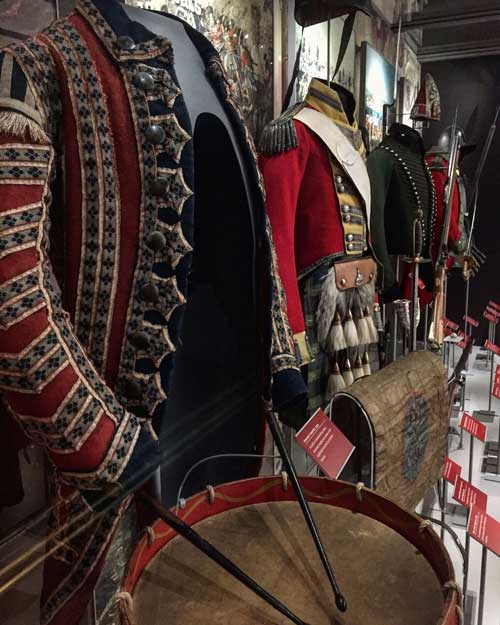
Visit a Redcoat Museum
There a dozens and dozens of military museums in Great Britain, but probably the one with the largest volume of paintings, uniforms, battle dioramas and mementos is the free National Army Museum. You'll find everything here from the musket ball that killed Sir Thomas Pincton at Waterloo to the skeleton of Napoleon's horse, named Marengo. You can even try on a British redcoat and (simulated) bear skin hat.
Judging by the size of uniform they provide, this exhibit might be intended for children. Still, when no one was around, I was able to squeeze into it and for one brief shining moment, looked like a proper (if somewhat old) Grenadier Guard.
Author Bio: Rich Grant is a freelance travel writer in Denver, Colorado and a member of the Society of American Travel Writers and the North American Travel Journalists Association. He is, along with Irene Rawlings, co-author of "100 Things to Do in Denver Before You Die," published by Reedy Press in 2016.
macqueennoins1972.blogspot.com
Source: https://www.goworldtravel.com/where-to-see-royal-guard/
0 Response to "Chinese Woman Dresses Up Kid as Brithish Palace Guard"
Post a Comment